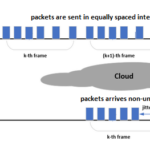Elementary AVC/H.264 stream does not contain timing information (excluding rare cases when presentation times are signaled in picture-timing SEI messages). Therefore, in order to encapsulate elementary stream into mp4 container or mpeg-system program it’s required to compute DTS/PTS (according to the predefined frame rate – fps) such that the following conditions are met:
1) DTS<=PTS
2) differences between PTS magnitudes of successive frames (in play order) is constant and equal to 1/fps (where fps is frame rate). In other words PTS of current frame differ from PTS of the previous frame (in presentation order) equal to the frame duration (i.e. 1/fps).
3) If HRD is used then PTS-DTS gap should be small in order not to violate DPB buffer.
Let’s for simplicity assume that both DTS and PTS are in frame duration units (in case of interlace video – in field duration units) – 1/fps seconds
Case 1: [B frames are not used]
DTS = PTS and DTS is proportional to the frame counter
Case 2: [B frames are present but not used as reference (i.e. no B-pyramid)]
Let’s assume that GOP structure is fixed in the sense that the interval M between two I/P frames in encoding order is constant, in order words M is equal to the number of B frames between successive I/P frames. For example, M for IPBBPBB… cadence is 2, M for IPBPBIB… cadence is 1 and M for IPPPPPP is 0 respectively
Calculation of DTS/PTS can be outlined as follows:
For the very first frame DTS = 0 and PTS = 1 (one frame period delay)
For other frames Do
If frame is B then PTS = DTS (since B frame is not used for reference and there is no sense to delay it in DPB)
If frame is P or I then PTS = DTS + M + 1
EndFor
If M is not constant (scene cuts can make encoders to break GOP structure) then take M equal to the maximal number of successive B-frames between I/P frames (in encoding order).
For example, for BluRay streams we know a-priory that M does not exceed 3 (BluRay spec. does not allow more than 3 consecutive B frames present).
There is a flaw in taking M as the maximal number of successive B-frames – we guarantee DTS<=PTS, however differences between PTS magnitudes of successive frames (in play order) might be not equal to the frame duration and consequently the playback might be stuttering.
The following example illustrates PTS stuttering:
Encoding order:
I0 P1 B2 B3 P4 B5 B6 B7 P8 B9
Play order
I0 B2 B3 P1 B5 B6 B7 P4 B9 P8
Take M = 3
Frame DTS PTS
I0 0 1
P1 1 5
B2 2 2
B3 3 3
P4 4 8
B5 5 5
B6 6 6
B7 7 7
P8 8 12
B9 9 9
So, PTS playback is not smooth because difference in PTS between two successive frames (in play order) e.g. B3 and P1 is 2 frame periods and not 1.
To resolve this PTS gap issue, for each I/P frame we have to look-ahead and to determine how many B frames following the current I/P frame.
If we come back to the above example, for P1 the interval M=2 and hence PTS of P1 equal to 4 instead of 5.

23+ years’ programming and theoretical experience in the computer science fields such as video compression, media streaming and artificial intelligence (co-author of several papers and patents).
the author is looking for new job, my resume





I have not checked in here for some time because I thought it was getting boring, but the last several posts are great quality so I guess I will add you back to my daily bloglist. You deserve it my friend 🙂
Some really fantastic info , Glad I detected this. “Never put off until tomorrow what you can do the day after tomorrow.” by Mark Twain.
You are my inspiration , I have few web logs and occasionally run out from to post : (.
I really appreciate this post. I have been looking all over for this! Thank goodness I found it on Bing. You’ve made my day! Thank you again
Great write-up, I¦m regular visitor of one¦s website, maintain up the nice operate, and It’s going to be a regular visitor for a long time.
Valuable information. Lucky me I found your website by accident, and I am shocked why this accident did not happened earlier! I bookmarked it.
Wonderful beat ! I would like to apprentice while you amend your website, how could i subscribe for a blog website? The account aided me a acceptable deal. I had been tiny bit acquainted of this your broadcast offered bright clear concept
I haven¦t checked in here for a while as I thought it was getting boring, but the last few posts are great quality so I guess I will add you back to my everyday bloglist. You deserve it my friend 🙂
Hi there very nice blog!! Guy .. Beautiful .. Amazing .. I will bookmark your website and take the feeds additionallyKI am satisfied to seek out a lot of helpful info right here within the post, we want develop more strategies on this regard, thanks for sharing. . . . . .
Good write-up, I?¦m regular visitor of one?¦s site, maintain up the excellent operate, and It is going to be a regular visitor for a long time.
I enjoy the efforts you have put in this, thanks for all the great blog posts.
Thanks a bunch for sharing this with all of us you really know what you are talking about! Bookmarked. Please also visit my site =). We could have a link exchange agreement between us!
pls. provide a link to your site, my email slavah264@gmail.com
Dear videonerd.website admin, Your posts are always well-timed and relevant.